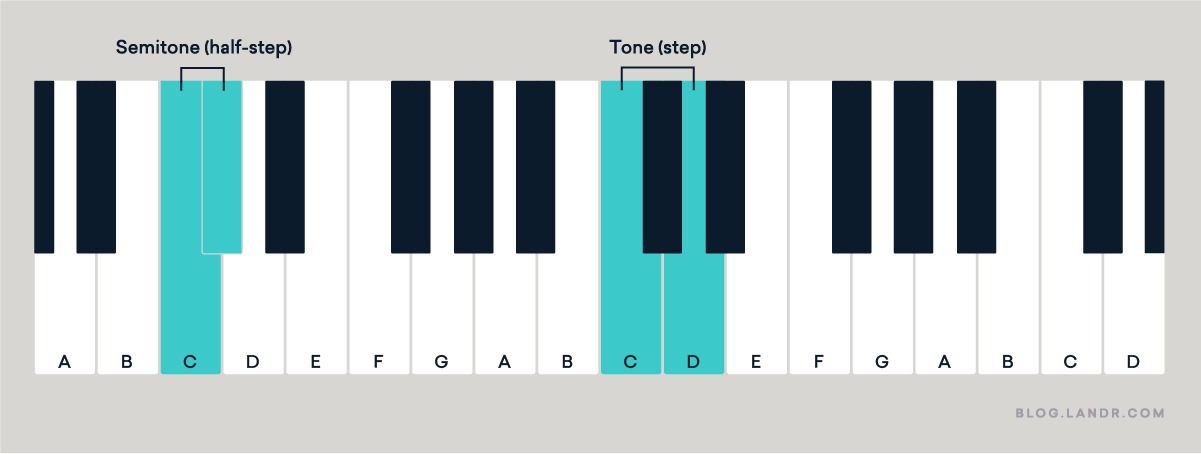
Pentatonic Scales: How to Use Music’s Most Versatile Scale

As a music-maker, you have unique assets at your disposal like talent, authenticity, and life experience.
Then, there are tools every artist can use to create great music like musical scales.
Pentatonic scales are the backbone of countless melodies. They’re perfect for creating the kind of hooks listeners will remember.
Pentatonic scales are a music theory concept that can be used in virtually every type of music.
They’re easy to learn and write with, but you might not know where to start if you haven’t seen them since piano or guitar lessons.
In this article we’ll answer the question, “What is a pentatonic scale?” You’ll also learn what pentatonic scales are, how they’re built, and how to use them in your music. But first, let’s talk about what exactly pentatonic scales are.
Theory guides, production tips, new free plugins, gear guides and more—delivered weekly
Keep up with the LANDR Blog.
What is a pentatonic scale?
Pentatonic scales are simple five-note scales. Developed by ancient civilizations, these scales are used in countless songs and compositions.
Pentatonic scales are split up into major and minor tonalities. These scales differ from conventional major and minor scales, which contain seven notes.
Easy to remember and perform, notes from these scales can either be sung or played with melodic instruments. Pentatonic scales are key features in blues, jazz, rock, and Asian music traditions.
However, these scales never seem to fall out of style. In modern music, you’re likely to hear pentatonic scales in everything from indie pop ballads to folk songs. Pentatonic patterns are unavoidable in popular music.
In modern music, you’re likely to hear pentatonic scales in everything from indie pop ballads to folk songs
Here are just a few examples of popular songs in the pentatonic scale:
The lead vocal of Taylor Swift’s 2018 song “Delicate” never strays out of the pentatonic scale:
The melody of “Amazing Grace” is built using only a pentatonic scale:
Black Sabbath’s “Paranoid” begins with an electric guitar riff that takes notes from a pentatonic scale:
How to build a pentatonic scale
Pentatonic scales are built following a pattern of tones and semitones that splits the octave into five notes. If you need a refresher on what tones and semitones are, head over to our guide to music theory guide.
Pentatonic scales are built following a pattern of tones and semitones that splits the octave into five notes.
To make things easy, I’m going to show you how to build these scales on the keyboard in the key of C major and A minor. However, they can be adapted to all melodic instruments and major and minor keys by memorizing simple note patterns.
Specifically, the note patterns you’ll need to memorize are tones and semitones. The distance between C and C# is a semitone, and the distance between C and D is a tone (two semitones). These are also commonly referred to as steps and half-steps in music theory.

How to play a pentatonic scale
The major pentatonic scale in the key of C is: C-D-E-G-A
Starting from the note of C, this scale is built with two tones that move from to D and then to E. Then, from the E note, you’ll move a tone and semitone up to G, followed by one last tone that ends on A.
T-T-T+TS-T = C-D-E-G-A
Using this same tone and semitone pattern, we can build pentatonic major scales in every other key. For example, in F major the pattern would be:
F-G-A-C-D:
Building the minor pentatonic scale
The minor pentatonic scale notes in A minor is: A-C-D-E-G
From A, move up one tone and one semitone to C. Then, move up a tone to D and another tone to E. On E, move a tone and semitone up to G and you’ll be on the last note of the scale.
Using the same tone and semitone pattern, let’s build the same pentatonic scale in D minor:
D-F-G-A-C:
How to use pentatonic scales in your music
Though we used a keyboard example to build these scales, these same pentatonic patterns can be applied to vocal melodies and other melodic instruments.
And just like other scales and modes, notes from these scales can be played in any order. Individual notes can be repeated as many times as you like, and not all notes in the scales need to be played.
When you feel stuck on a specific idea in your music, trying out notes from these scales is a great way to move forward.
There are countless ways you can apply major and minor pentatonic scales to your music. From synth riffs to vocal melodies, they’re easy to perform and are incredibly catchy. When you feel stuck on a specific idea in your music, trying out notes from these scales is a great way to move forward.
One of the best ways to experiment with pentatonic patterns is to try out notes you play over looped chord progressions. Using your DAW or playing with a band are easy ways to do this.
Over time, you’ll gravitate towards specific melodies. Have a recording device out and ready to keep track of your best ideas.
What are the five notes of the pentatonic scale?
The word “pentatonic” can be broken down into “penta” or five and “tonic” which means tone. In other words, the pentatonic scale is made up of five tones, or notes. The specific notes will depend on which key you use.
To find the pentatonic scale in a particular key, begin with the major scale and choose the first, second, third, fifth, and sixth notes. You can also find the relative minor pentatonic scale by using the same pattern but starting on the sixth note of the relative major scale.
The two most popular pentatonic scales come from the C major scale and its relative A minor scale.
These scales look like:
- C Major: C-D-E-G-A
- C Minor: A-C-D-E-G
Which pentatonic scale should I learn first?
If you’re a beginner, start familiarizing yourself with the pentatonic scale by playing the C major pentatonic scale notes: C-D-E-G-A.
Feel free to tinker with the notes in the scale to create fresh melodies within the pentatonic scale.
When you get comfortable with the C major scale, start transposing to different keys. Try a D major pentatonic scale (D-E-F#-A-B), an A major scale: (A-B-C#-E-F#) and keep going.
You can also start practicing with minor pentatonic scales, such as the A minor scale of A-C-D-E-G which was discussed earlier.
How do you read a pentatonic scale?
Pentatonic scales can be a little challenging to learn and read until you understand the pentatonic pattern behind the notes.
To read and play any major pentatonic scale, you’ll need to memorize the note pattern of: first note, second, third, fifth, and sixth. Once you understand this pattern, you can apply it to any key.
The minor pentatonic scale is a little tricky, but, again, once you understand the pattern, you’ll be able to read it in any scale.
The minor pentatonic scale follows the same pattern as the major scale, but it begins on the fifth note of the scale instead of the first.
Now you know how to play the pentatonic scale! The best way to easily read the pentatonic scale is to practice the scales in a range of major and minor keys.
Then it will soon become second nature.
What is the difference between a pentatonic and a full scale?
The two primary differences between a pentatonic scale and a full scale (also known as a diatonic scale) are the number of notes in the scale and the intervals between the notes.
A pentatonic scale includes just five notes, (“penta” stands for “five”), while a full scale includes seven notes.
In the pentatonic scale, the five notes are spread farther apart, meaning they have larger intervals.
This is in contrast to the diatonic scale, where the notes are closer together.
How do these differences impact the sound in each scale? For one, fewer notes in the pentatonic scale mean it is simpler to learn and use than the diatonic scale
The pentatonic scale is heavily associated with blues and rock music, especially since the blues scale is an adapted version of the minor pentatonic scale.
When learning to solo over a 1-4-5 blues chord progression it’s often the first scale new musicians will practice, since any note from the minor pentatonic scale of the same key will sound good.
Listen to any rock or blues music and you’ll start hearing tons of pentatonic riffs and licks throughout.
Essential musical scales
The beautiful thing about pentatonic scales is their simplicity.
Five notes gives you access to countless ideas and help you find direction for your melodies. With your DAW giving you endless instrumental and production choices, pentatonic scales help ground your music.
Interested in learning more? Join the LANDR community today to take your music to the next level.
Gear guides, tips, tutorials, inspiration and more—delivered weekly.
Keep up with the LANDR Blog.



